Early Victorian Pagoda Topped Stick Barometer By Bate Of London
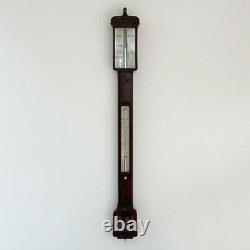

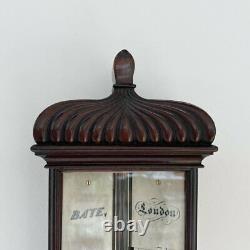
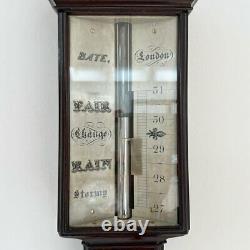

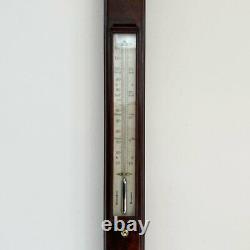

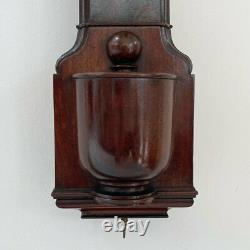
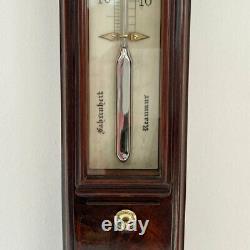
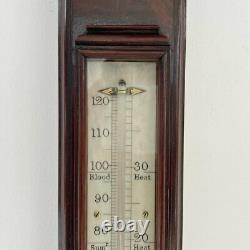

For sale, an early Victorian mahogany Stick Barometer by Bate of London. This magnificent example is comprised of a flame mahogany veneered body with an unusual pagoda topped pediment design with reeded detailing. Below is a glass fronted, inverted scale with an engraved bone plate either side of the barometer tube. It measures 27 to 31 inches of barometric pressure with standard weather indications and the head of the plate is engraved to the famous maker, Bate, London. The right hand scale section is also accompanied by an adjustable Vernier for fine measurement and is operated by a mahogany setting adjuster below.
The trunk of the barometer has chamfered edge detailing running along each edge and has a glazed thermometer case at its centre. The thermometer has a bone engraved scale reading for Fahrenheit on the left and Reamur on the right. The raised case has a graduated base and pediment and may be removed for use elsewhere by means of a brass button press below.
The barometer is beautifully completed with a classical urn shaped cistern cover and the base is provided with a travel screw which can be operated by removing the set adjuster knob and attaching it to the end. Born in 1782, to a family of Bankers in Stourbridge, he initially travelled to London to become a Haberdasher under his Uncle Robert Brettell.
His Aunt also living in London was married to Bartholomew Sikes, famous for winning favour with The Board of Excise for his hydrometer design in 1802. In 1804, Robert Bate married his cousin, the daughter of his aunt Mary and Bartholomew Sikes, however it was followed quite shortly with the sudden death of Sikes. Supported by his newly widowed Aunt, Bate took over Sike's business and its Government commission and successfully persuaded the Board of Excise to adopt the "improved" hydrometer that his Father in Law had been working on before his untimely death. At this time, the company was being run at 17 Poultry where in 1814 he became a member of the Spectacle Maker's Company of London, by 1824 his reputation was such that he was further commissioned by the Board of Excise & Ordnance to make the new national standard Imperial measures for weight & capacity created by George IV, this event led Bate to acquire further premises at 20 and 21 Poultry.It was this Governmental relationship that underpinned his entire career, leading to an important commission from the US Mint where his Troy pound standard weight became legal standard for US coinage at the time and his instruments were also known to have been used by The East India Company, The Royal Navy, The Board of Ordnance, The Hydrographic Office and The Bank of England. His quality of manufacture led him to receive Royal Appointments from George IV, William IV and Queen Victoria where he acted as Optician and he eventually rose to become Master of the Spectacle Maker's Guild in 1833. He was also known to have acted for the Admiralty as its main chart agent with numerous sub agents acting below him such as his old apprentice and instrument maker to The Royal yacht Club, George Stebbing. The final two decades of his life (the 1830's and 40's) were riddled with ill health probably due to the amount of work that he was undertaking.
He travelled widely across the UK and abroad for health reasons but still maintained lively correspondence with his customers. Bate's widow continued to run the business until 1850 whereafter the Excise work was taken over by Dring & Fage and the Admiralty Chart side of the business went to Bate's former employee, John Dennett Potter. A very unusual and interestingly designed stick barometer by a top London maker of the period. Jason Clarke Antiques are happy to discuss carriage, condition or for any other queries, alternatively, you can also message us and we will endeavour to come back to you as soon as possible. This item is in the category "Antiques\Science/Medicine\Scientific Instruments".The seller is "jason750_1" and is located in this country: GB. This item can be shipped to United Kingdom.
- Period: 1800 to 1900
- Antique: Yes
- Material: Mahogany
- Type: Barometer

